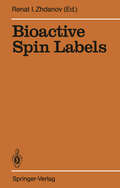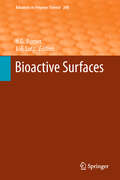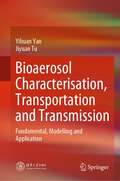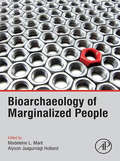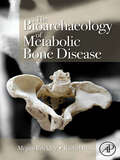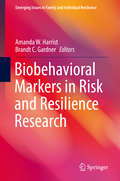- Table View
- List View
Bioactive Spin Labels
by Renat I. ZhdanovBioactive Spin Labels is a collection of contributions by leading experts on nitroxyl radicals and their application in biomedicine. These compounds are used as side specific contrast agents for in-vivo EPR techniques. Their potential as drugs is investigated. Bioactive Spin Labels is a must for researchers in bioorganic chemistry, pharmacology and biomedicine.
Bioactive Surfaces (Advances in Polymer Science #240)
by Hans G. Börner and Jean-Francois LutzErik Wischerhoff, Nezha Badi, André Laschewsky and Jean-François Lutz Smart Polymer Surfaces: Concepts and Applications in Biosciences; S. Petersen, M. Gattermayer and M. Biesalski Hold on at the Right Spot: Bioactive Surfaces for the Design of Live-Cell Micropatterns; Julien Polleux Interfacing Cell Surface Receptors to Hybrid Nanopatterned Surfaces: A Molecular Approach for Dissecting the Adhesion Machinery; Abigail Pulsipher and Muhammad N. Yousaf Self-Assembled Monolayers as Dynamic Model Substrates for Cell Biology; D. Volodkin, A. Skirtach and H. Möhwald LbL Films as Reservoirs for Bioactive Molecules; R. Gentsch and H. G. Börner Designing Three-Dimensional Materials at the Interface to Biology; Joerg C. Tiller Antimicrobial Surfaces;
Bioactives and Pharmacology of Lamiaceae (AAP Focus on Medicinal Plants)
by T. PullaiahThis new book provides a wealth of information on plants in the Lamiaceae family, noted for their essential oils and bioactives and pharmacological properties. The chapters investigate a wide variety of species, providing for each an introduction, characteristics, properties, distribution, traditional uses, and current and potential pharmacological applications. Aiming to be a resource for the development of new drugs based on species within the Lamiaceae family, the volume discusses 26 species, including bungleweed (Ajuga), Malabar catmint (Anisomeles malabarica), beechwood (Gmelina arborea), Brazilian mint (Hyptis crenata), rosemary (Rosmarinus officinalis L.), holy basil (Ocimum tenuiflorum), and many more. Edited by the noted botanist T. Pullaiah, PhD, this new volume under his AAP Focus on Medicinal Plants book series, will be a valuable reference for those in drug discovery, botany, and fragrance chemistry.
Bioactives and Pharmacology of Lamiaceae (AAP Focus on Medicinal Plants)
This new book provides a wealth of information on plants in the Lamiaceae family, noted for their essential oils and bioactives and pharmacological properties. The chapters investigate a wide variety of species, providing for each an introduction, characteristics, properties, distribution, traditional uses, and current and potential pharmacological applications. Aiming to be a resource for the development of new drugs based on species within the Lamiaceae family, the volume discusses 26 species, including bungleweed (Ajuga), Malabar catmint (Anisomeles malabarica), beechwood (Gmelina arborea), Brazilian mint (Hyptis crenata), rosemary (Rosmarinus officinalis L.), holy basil (Ocimum tenuiflorum), and many more. Edited by the noted botanist T. Pullaiah, PhD, this new volume under his AAP Focus on Medicinal Plants book series, will be a valuable reference for those in drug discovery, botany, and fragrance chemistry.
Bioactives and Pharmacology of Legumes
by T. PullaiahIn this comprehensive desk reference, a variety of bioactives and therapeutics from the legume family (Fabaceae or Leguminosae) are thoroughly detailed. For each species included in the volume, a brief introduction is given, the plant’s bioactive compounds are listed, and its chemical structures shown, followed by their pharmacological activities. Many of these plants have medicinal activities that include antiviral, antimicrobial, antioxidant, anticancer, anti-inflammatory, and antidiabetic, hepatoprotective, nephroprotective and cardioprotective. The biochemical characteristics of the 37 plants included, such as the type of starch, protein, and fibers, can be exploited as binders, excipients, thickeners, and dispersants in the formulation of various products in the pharmaceutical industry. The published literature on the pharmacological activities on each species is reviewed and presented in a concise and clear manner. This will be an important source book for pharmaceutical researchers, scientists, and others in development of new drugs.
Bioactives and Pharmacology of Legumes
In this comprehensive desk reference, a variety of bioactives and therapeutics from the legume family (Fabaceae or Leguminosae) are thoroughly detailed. For each species included in the volume, a brief introduction is given, the plant’s bioactive compounds are listed, and its chemical structures shown, followed by their pharmacological activities. Many of these plants have medicinal activities that include antiviral, antimicrobial, antioxidant, anticancer, anti-inflammatory, and antidiabetic, hepatoprotective, nephroprotective and cardioprotective. The biochemical characteristics of the 37 plants included, such as the type of starch, protein, and fibers, can be exploited as binders, excipients, thickeners, and dispersants in the formulation of various products in the pharmaceutical industry. The published literature on the pharmacological activities on each species is reviewed and presented in a concise and clear manner. This will be an important source book for pharmaceutical researchers, scientists, and others in development of new drugs.
Bioactivity of Engineered Nanoparticles (Nanomedicine and Nanotoxicology)
by Bing Yan Hongyu Zhou Jorge L. Gardea-TorresdeyThis book brings together reviews from international experts who are exploring the biological activities of nanomaterials for medical applications or to better understand nanotoxicity. Topics include but are not limited to the following: 1) mechanistic understanding of nanostructure-bioactivity relationships; 2) the regulation of nanoparticles’ bioactivity by means of chemical modification; 3) the new methodologies and standard methods used to assess nanoparticles’ bioactivity; 4) the mechanisms involved in nanoparticle-biomolecule interactions and nanoparticle-cell interactions; and 5) biomedical applications of nanotechnology. The book will be a valuable resource for a broad readership in various subfields of chemical science, engineering, biology, environment, and medicine.
Bioadhesion and Biomimetics: From Nature to Applications
by Havazelet Bianco-Peled Maya Davidovich-PinhasBioadhesion is often defined as the state in which two materials, at least one of which is biological in nature, are held together for extended periods of time by interfacial forces. It is an area of active multidisciplinary research, where engineers, scientists-including chemists, physicists, biologists, and medical experts-materials' producers, a
Bioaerosol Characterisation, Transportation and Transmission: Fundamental, Modelling and Application
by Yihuan Yan Jiyuan TuThis book aims to predict and model the transport of bioaerosols, identify their transmission characteristics, and assess occupants’ infection risks. Although existing epidemiological books provide fundamental infection rate of existing diseases, the ability of predicting emerging disease transmission in the air and assessing occupants’ infection risks to the bioaerosols is significantly lacking. This book is considered as a professional book that provides in-depth discussion of the aforementioned issues and provides potential approaches to solve these issues would be highly demanded by readers in this emerging research field. This book offers essential and systematic analysis on the fate of bioaerosols from their release in the air to the final destination in human’s respiratory systems through direct 3D visualizations techniques. It also provides quantifiable method to assess each occupant’s infection risks to the infectious bioaerosols in indoor environments. The readers will gain essential fundamental characteristics of bioaerosols (active time, viability, etc.) and will gain the advanced skills on how to integrate these properties into numerical modeling and assess the occupants’ exposure risks.
Bioarchaeology of Marginalized People
by Madeleine L. Mant Alyson Jaagumägi HollandBioarchaeology of Marginalized People amplifies the voices of marginalized or powerless individuals. Following previous work done by physical anthropologists on the biology of poverty, this volume focuses on the voices of past actors who would normally be subsumed within a cohort or whose stories represent those of the minority. The physical effects of marginalization – manifest as skeletal markers of stress and disease – are read in their historical contexts to better understand vulnerability and the social determinants of health in the past. Bioarchaeological, archaeological, and historical datasets are integrated to explore the varied ways in which individuals may be marginalized both during and after their lifespan. By focusing on previously excluded voices this volume enriches our understanding of the lived experience of individuals in the past. This volume queries the diverse meanings of marginalization, from physical or social peripheralization, to identity loss within a majority population, to a collective forgetting that excludes specific groups. Contributors to the volume highlight the histories of individuals who did not record their own stories, including two disparate Ancient Egyptian women and individuals from a high-status Indigenous cemetery in British Columbia. Additional chapters examine the marginalized individuals whose bodies comprise the Robert J. Terry anatomical collection and investigate inequalities in health status in individuals from Canada, the United States, and the United Kingdom. Modern clinical population health research is examined through a historical lens, bringing a new perspective to the critical public health interventions occurring today. Together, these papers highlight the role that biological anthropologists play both in contributing to and challenging the marginalization of past populations.Highlights the histories and stories of individuals whose voices were silenced, such as workhouse inmates, migrants, those of low socioeconomic status, the chronically ill, and those living in communities without a written languageProvides a holistic and more complete understanding of the lived experiences of the past, as well as changes in populations through timeOffers an interdisciplinary discussion with contributions from a wide variety of international authors
The Bioarchaeology of Metabolic Bone Disease
by Megan B. Brickley Rachel IvesThe Bioarchaeology of Metabolic Bone Disease provides a comprehensive and invaluable source of information on this important group of diseases. It is an essential guide for those engaged in either basic recording or in-depth research on human remains from archaeological sites. The range of potential tools for investigating metabolic diseases of bone are far greater than for many other conditions, and building on clinical investigations, this book will consider gross, surface features visible using microscopic examination, histological and radiological features of bone, that can be used to help investigate metabolic bone diseases.Clear photographs and line drawings illustrate gross, histological and radiological features associated with each of the conditionsCovers a range of issues pertinent to the study of metabolic bone disease in archaeological skeletal material, including the problems that frequent co-existence of these conditions in individuals living in the past raises, the preservation of human bone and the impact this has on the ability to suggest a diagnosis of a conditionIncludes a range of conditions that can lead to osteopenia and osteoporosis, including previous investigations of these conditions in archaeological bone
Bioarrays: From Basics to Diagnostics
by Sir E. M. Southern Krishnarao AppasaniThis book provides an integrated collection of timely articles on the use of bioarray techniques in the fields of biotechnology and molecular medicine. It is the first book to comprehensively integrate molecular diagnostics and molecular pathology. This book serves as an indispensable reference for graduate students, post-docs, and professors as well as an explanatory analysis for executives and scientists in biotechnology and pharmaceutical companies.
Bioassay Methods in Natural Product Research and Drug Development (Proceedings of the Phytochemical Society of Europe #43)
by Lars Bohlin Jan G. BruhnBioassay Methods in Natural Product Research and Drug Development contains the proceedings from the Phytochemical Society of Europe's very successful symposium on this topic, held August 24-27, 1997 in Uppsala, Sweden. In this volume, leading academic and industrial scientists discuss novel methods for assaying natural products to find new structure-activity relationships. Of key importance in this process is the availability and reliability of specific bioassay methods, but chapters also discuss chemical and biological diversity and how to dereplicate natural product extracts to increase efficiency in lead discovery. Anti-tumor, HIV-inhibitory, antiprotozoal, anti-infective and immunomodulatory natural products are discussed. Various industrial projects are presented for the first time. This volume bridges the gap between academic and industrial research and scientists, and should be required reading in drug companies and faculties of pharmacy, as well as serving scientists in pharmacognosy, pharmacology, phytochemistry, natural products and drug discovery.
Bioassay of Anterior Pituitary and Adrenocortical Hormones, Volume 5: Colloquia on Endocrinology (Novartis Foundation Symposia)
by G. E. W. WolstenholmeThe Novartis Foundation Series is a popular collection of the proceedings from Novartis Foundation Symposia, in which groups of leading scientists from a range of topics across biology, chemistry and medicine assembled to present papers and discuss results. The Novartis Foundation, originally known as the Ciba Foundation, is well known to scientists and clinicians around the world.
Bioassays in Experimental and Preclinical Pharmacology (Springer Protocols Handbooks)
by Karuppusamy Arunachalam Sreeja Puthanpura SasidharanThis detailed book explores protocols for a wide array of preclinical pharmacology and toxicology evaluations to be applied to chemical drugs and their development through in vitro, involving tissues and cell lines, and in vivo models, using animals as experimental systems, utilized to conduct pharmacological research. Written for the Springer Protocols Handbooks series, the methodologies included in this collection have been standardized by the authors through extensive use in the lab so that they are ready to be applied in the labs of readers around the world. Authoritative and practical, Bioassays in Experimental and Preclinical Pharmacology aims to assist undergraduate and postgraduate students, research scholars, scientists, and other academicians performing research in the vital field of drug discovery.
Bioavailability and Analysis of Vitamins in Foods
by G. F. BallEvery country in the world is concerned with the nutritional status of its population and in utilizing its natural food resources in the most effective way possible. Surveys based on food intakes and food compositional data are being conducted with the object of establishing recommended intakes of vitamins. These recommendations are constantly being changed as new knowledge comes to light. Analytical techniques using physicochemical and microbiological methods have been largely developed to determine the total vitamin content of a food commodity or diet using the most rigorous extraction method commensurate with the stability of the vitamin. The extraction procedures frequently involve prolonged heating of suitably prepared food samples at extremes of pH to liberate vitamins from chemically bound forms in the food matrix or to remove a preponderance of fat from fatty foods. For several vitamins the data obtained by these means grossly overestimate the nutritional value of the food because the human digestive system fails to liberate bound vitamin forms for subsequent absorption by the intestine. This statement is borne out by reports of vitamin deficiency in situations where the dietary supply of vitamin is adequate on the basis of conventional analysis. Various research labora tories are directing their effort toward the estimation of bioavailable vitamin, i. e. the proportion of vitamin in the food which is available for utilization by the body. So far, few data have been published and there are many gaps in the knowledge required to interpret experimental results.
Biobanking: Methods and Protocols (Methods in Molecular Biology #1897)
by William H. YongThis volume not only discusses various common biobanking topics, it also delves into less-discussed subjects such as what is needed to start a biobank, training of new biobanking personnel, and ethnic representation in biospecimen research. Other chapters in this book span practical topics including: disaster prevention and recovery; information technology; flora and fauna preservation including zoological fluid specimen photography; surgical and autopsy biobanking; biobanking of bodily fluids; biosafety; cutting frozen sections; immunohistochemistry; nucleic acid extraction; and biospecimen shipping. Written in the highly successful Methods in Molecular Biology series format, chapters include introductions to their respective topics, lists of the necessary materials and reagents, step-by-step, readily reproducible laboratory protocols, and tips on troubleshooting and avoiding known pitfalls.Unique and comprehensive, Biobanking: Methods and Protocols is a valuable resource for novice and practicing biobankers, and for end-user researchers. This book aims to bring new insight into the field and expand on current biomedical biobanking studies.
Biobanking of Human Biospecimens: Principles and Practice
by Pierre Hainaut Jim Vaught Kurt Zatloukal Markus PasterkThis volume is the first comprehensive text on human biobanking, authored by scientists and regulatory officers who have led the field over the past 10 years. It covers biobanking issues and its importance in advancing the field of research in cancer, cardiovascular, metabolic, and other diseases. Biobanks of human specimens have become the cornerstone for research on human health that harnesses the power of “omics” technologies to identify biomarkers for disease susceptibility. Biobanks are an essential component of the development of personalized medicine, which relies on the molecular analysis of biospecimens that are truly representative of individuals and of diseases. Over the past decade, biobanking has been the focus of major investments and developments aimed at developing appropriate infrastructure, methods, networking practice and evidence-based pre-analytical procedures. This volume explores topics including specimen storage, protocol design, specimen collection, pre-analytical processing and preservation, long-term storage, retrieval and separation, and distribution to analytical laboratory platforms. These activities are extremely complex and are essential for biomedical and biotechnological developments and this text provides critical information about biobanking for the development of future forms of medicine.
Biobanking of Human Biospecimens: Lessons from 25 Years of Biobanking Experience
by Pierre Hainaut Jim Vaught Kurt Zatloukal Markus PasterkOver the past 25 years, biobanks of human specimens have become a cornerstone for research on human health and have empowered the “omics “revolution that characterizes biomedical science in the XXIst Century. Today, biobanking of human specimens is a critical component of the interface between clinical practice and translational research, supporting the discovery and validation of new biomarkers of disease etiology, risk, early detection, diagnosis, prognosis, prediction and relapse. With the development of personalized medicine, biobanking of cryopreserved specimens has become standard practice in order to investigate genetic, transcriptomic, proteomic, metabolomics and immunological biomarkers useful to inform caregivers for therapeutic decisions. Data generated from biobanked specimens represent a rapidly growing and highly valuable resource, participating in the emergence of Big Data Medicine. With the development of large computing capabilities and artificial intelligence, data associated with biobanked specimens constitute a unique resource for the discovery and validation of new biomarkers and therapeutically actionable targets. Interconnecting, interoperating and sharing this data have become major issues for national health systems, raising enormous stakes as well as major societal, legal and cybersecurity challenges in terms of compliance with the protection of personal sensitive information. This book project is the second part of an initiative launched in 2012 to produce a published corpus of knowledge encompassing all aspects of human biobanking as a central practice for research and medicine. The first volume, published in 2017, is entitled: Human Biobanking: Principles and Practice. This first volume compiled a series of high level contributions overseeing the main developments that carried the progression of human biobanking as a research and biotechnological field over the past two decades. This new book project will constitute de facto Volume 2 of the same initiative, under the title: Biobanking of Human Biospecimens: lessons from 25 years of biobanking experience. Hence, the two volumes will share the same generic title (Biobanking of Human Biospecimens), with different subtitles, making clear that the two volumes are interrelated while highlighting their specificities in terms of what they actually cover. As a result, the two books are “twins” but can also be used independently of each other.The overarching aim of the two volumes of Biobanking of Human Biospecimens is to provide a published “one-stop shop” for state-of-the-art information on what constitutes the field of human biobanking, from conception of a biobank, standard operating procedures, ethical and societal aspects, governance, networking, interoperability and economic sustainability. This inclusive publication concept meets the needs of a vast readership, including scientists, doctors and technical staffs who are directly involved in biobanking operations, scientists in other disciplines that heavily rely on biobanking (such as genomics or proteomics), stakeholders and policy makers, and of course students for whom biobanking is becoming an important part of the training curriculum. So far, there has been a lack of major textbooks on biobanking. Documentation for biobanking is widely available through numerous publications, regulatory documents published by International or Governmental Agencies, and sets of recommendations essentially accessible through the Internet. However, it is difficult to access a single, top-of-the shelf reference that provides at a glance a large coverage of all aspects of human biobanking. Fulfilling this need is the main origin of the concept for this back-to-back publication project. To our knowledge, there is currently no other publication project with the same breath and scope as this one in the field of biobanking.
Biobanks: Governance in Comparative Perspective
by Herbert Gottweis Alan PetersenIn recent years, a number of large population-based biobanks – genetic databases that combine genetic information derived from blood samples with personal data about environment, medical history, lifestyle or genealogy – have been set up in order to study the interface between disease, and genetic and environmental factors. Unsurprisingly, these studies have sparked a good deal of controversy and the ethical and social implications have been widely debated. Biobanks: Governance in Comparative Perspective is the first book to explore the political and governance implications of biobanks in Europe, the United States, Asia, and Australia. This book explores: the interrelated conditions needed for a biobank to be created and to exist the rise of the new bio-economy the redefinition of citizenship accompanying national biobank developments This groundbreaking book makes clear that biobanks are a phenomenon that cannot be disconnected from considerations of power, politics, and the reshaping of current practices in governance. It will be a valuable read for scholars and students of genetics, bioethics, risk, public health and the sociology of health and illness.
Biobanks: Governance in Comparative Perspective
by Herbert Gottweis Alan PetersenIn recent years, a number of large population-based biobanks – genetic databases that combine genetic information derived from blood samples with personal data about environment, medical history, lifestyle or genealogy – have been set up in order to study the interface between disease, and genetic and environmental factors. Unsurprisingly, these studies have sparked a good deal of controversy and the ethical and social implications have been widely debated. Biobanks: Governance in Comparative Perspective is the first book to explore the political and governance implications of biobanks in Europe, the United States, Asia, and Australia. This book explores: the interrelated conditions needed for a biobank to be created and to exist the rise of the new bio-economy the redefinition of citizenship accompanying national biobank developments This groundbreaking book makes clear that biobanks are a phenomenon that cannot be disconnected from considerations of power, politics, and the reshaping of current practices in governance. It will be a valuable read for scholars and students of genetics, bioethics, risk, public health and the sociology of health and illness.
Biobanks and Tissue Research: The Public, the Patient and the Regulation (The International Library of Ethics, Law and Technology #8)
by Christian Lenk Judit Sándor Bert GordijnThe research field of biobanks and tissue research is highly promising. Many projects around the globe are involved in the collection of human tissue and health data for research purposes. These initiatives are driven by the perspective of decisive breakthroughs in the knowledge of the genetic pathways involved in widespread diseases. However, there are considerable ethical and legal challenges to be considered as well. These challenges encompass the use of body material for research purposes, the misuse of genetic and other health data by third parties, trust in science and medicine, concerns regarding privacy, use of genetic data for forensic applications by the state and the police, and regulatory issues. This volume is divided into three parts: the inclusion of the public, the rights of donors and patients, examples and recommendations for the future of tissue research. It presents a comprehensive overview of the most important topics in the field by renowned scholars in medical ethics and biolaw.
Biobased Nanomaterials: Applications in Biomedicine, Food Industry, Agriculture, and Environmental Sustainability
by Shakeel AhmedThis book comprehensively covers various aspects of biobased nanomaterials, including their types, fabrication methods, characterization techniques, and applications in different fields. The book starts with an introduction to biobased nanomaterials, highlighting their significance in various fields due to their unique properties. The first few chapters cover the different types of biobased nanomaterials, their properties, and how they are extracted from various natural sources. The methods of fabrication of biobased nanomaterials are discussed in detail, including the techniques for controlling their size, shape, and composition. It then delves into the characterization of biobased nanomaterials, discussing the different techniques used to determine their properties, including their morphology, size, structure, and composition. The subsequent chapters explore the various applications of biobased nanomaterials in different fields such as environmental applications, wound healing, tissue engineering, food industry, agriculture, sensing technology, biomedical applications, and energy storage devices. The advantages of biobased nanomaterials over traditional nanomaterials are highlighted, including their biodegradability and sustainability. The environmental concerns associated with biobased nanomaterials, as well as the health and safety concerns, are also discussed. The book concludes by looking at the prospects of biobased nanomaterials and how they can contribute to sustainable development. Overall, the book is an informative and comprehensive book that provides a thorough understanding of biobased nanomaterials and their various applications. It is a valuable resource for researchers, students, and professionals in various fields such as materials science, chemistry, biology, and environmental science. alike.
Biobehavioral Approaches to Pain
by Rhonda J. MoorePain is a common symptom, yet it is frequently underevaluated and undertreated. It is difficult to define, describe—and sometimes to prove. It’s pain, and suspicions of exaggerations often add further insult to a patients’ injuries. Biobehavioral Approaches to Pain translates this highly subjective experience—and its physical, psychological, social, and cultural dimensions—into practical insights key to transforming the field of pain management. This pathbreaking volume synthesizes a rich knowledge base from across disciplines, including neurobiologic, genetic, biobehavioral, clinical, narrative, substance abuse, health services,ethical and policy perspectives, for a deeper understanding of the impact of pain on individual lives and the larger society. Its international panel of contributors highlights special issues and review best practice guidelines, from placebo effects to cancer, Whiplash Associated Disorders to pain imaging to complementary medicine, phantom limb pain to gene therapies to AIDS. Among the topics covered: The distinction between acute and chronic pain: is it clinically useful? Improving clinical assessment of patients with pain. Age and sex differences in pain. The what, how and why of the placebo and nocebo effect Psychosocial and partner-assisted biopsychosocial interventions for disease-related pain Substance abuse issues in pain treatment. The personal, social and economic costs of chronic pain. Biobehavioral Approaches to Pain offers clinical and health professionals, psychologists, as well as specialists in pain management or palliative care, new directions in their ongoing dialogue with patients. Given the prevalence of pain in the general population, it should also interest researchers and students in the field of public health.
Biobehavioral Markers in Risk and Resilience Research (Emerging Issues in Family and Individual Resilience)
by Amanda W. Harrist Brandt C. GardnerThis comprehensive reference explores the current and future state of biobehavioral markers in family resilience research, with special focus on linking biological and physiological measures to behavioral and health outcomes. It brings together the latest biobehavioral data on child-parent and couple relationships, adversity, and other key areas reflecting new technological advances in biobehavioral studies and translates these findings into implications for real-world practice and policy. The contributors’ insights on biomarkers apply to emerging topics of interest (e.g., molecular genetics) as well as familiar ones (e.g., stress). Their interdisciplinary perspective helps to elaborate on risk and resilience factors for those creating the next generation of evidence-based interventions.Among the topics covered:The immune system as a sensor and regulator of stress: implications in human development and diseaseThe psychobiology of family dynamics: bidirectional relationships with adrenocortical attunementIntergenerational transmission of poverty: how low socioeconomic status impacts the neurobiology of two generationsThe influence of teacher-child relationships on preschool children’s cortisol levelsChallenges and strategies for integrating molecular genetics into behavioral scienceBesides its worth to researchers and practitioners studying and working with families at risk, Biobehavioral Markers in Risk and Resilience Research also has utility as a training text, offering a highly accessible presentation and discussion questions suited to classroom use.
